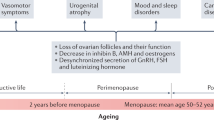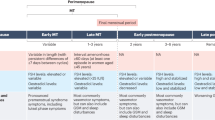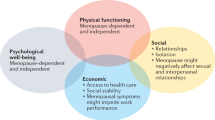Abstract
Many postmenopausal women live with diabetes mellitus; however, little information is available about how the changes that occur around the time of menopause might uniquely affect management of diabetes mellitus in this population. Although the weight gain that commonly occurs during the menopausal transition is largely attributable to aging rather than the transition itself, changes in body composition have been independently associated with menopausal status. These changes in body composition have, in turn, been associated with alterations in insulin sensitivity and glucose metabolism in postmenopausal women. Hormone therapy seems to have neutral or beneficial effects on the adverse changes in body composition associated with menopause. Whether menopausal status independently influences diabetes risk remains controversial. Nevertheless, consistent findings from large clinical trials suggest that postmenopausal hormone therapy decreases the risk of developing diabetes mellitus. Similarly, many studies suggest that postmenopausal hormone therapy has neutral or beneficial effects on glycemic control among women already diagnosed as having diabetes mellitus. Future studies are needed to elucidate the mechanisms that underlie these relationships and to determine how these observations should influence recommendations for the care of postmenopausal women with diabetes mellitus.
Key Points
-
Menopause has been associated with changes in body composition, which in turn have been linked to adverse changes in insulin sensitivity and glucose metabolism
-
Hormone therapy seems to have neutral or beneficial effects on the adverse changes in body composition associated with menopause
-
Whether menopausal status independently influences diabetes risk remains controversial
-
Some evidence suggests that postmenopausal hormone therapy decreases the risk of developing diabetes mellitus
-
Postmenopausal hormone therapy has neutral or beneficial effects on glycemic control among women already diagnosed as having diabetes mellitus
-
Further studies are needed to determine how these observations will affect clinical practice; in the meantime, postmenopausal hormone therapy should not be prescribed for the purpose of diabetes prevention
This is a preview of subscription content, access via your institution
Access options
Subscribe to this journal
Receive 12 print issues and online access
$209.00 per year
only $17.42 per issue
Buy this article
- Purchase on Springer Link
- Instant access to full article PDF
Prices may be subject to local taxes which are calculated during checkout
Similar content being viewed by others
References
Department of Health and Human Services Centers for Disease Control and Prevention. National diabetes fact sheet 2007 [online], (2008).
Day, J. C. National Population Projections. US Census Bureau: Population Profile of the United States [online], (2009).
Legato, M. J. et al. Gender-specific care of the patient with diabetes: review and recommendations. Gend. Med. 3, 131–158 (2006).
Soules, M. R. et al. Executive summary: Stages of Reproductive Aging Workshop (STRAW). Fertil. Steril. 76, 874–878 (2001).
Gold, E. B. et al. Factors associated with age at natural menopause in a multiethnic sample of midlife women. Am. J. Epidemiol. 153, 865–874 (2001).
Nelson, H. D. Menopause. Lancet 371, 760–770 (2008).
Bulun, S. E. & Adashi, E. Y. in Williams Textbook of Endocrinology Edn 10 (eds Larsen, P. R. et al.) 587–664 (Saunders, Philadelphia, 2003).
Dougherty, P. & Pastors, J. G. Women & diabetes. Menopause. What to expect, how to cope. Diabetes Self Manag. 24, 84–87 (2007).
Salonia, A. et al. Sexual function and endocrine profile in fertile women with type 1 diabetes. Diabetes Care 29, 312–316 (2006).
Jackson, S. L., Scholes, D., Boyko, E. J., Abraham, L. & Fihn, S. D. Urinary incontinence and diabetes in postmenopausal women. Diabetes Care 28, 1730–1738 (2005).
Dorman, J. S. et al. Menopause in type 1 diabetic women: is it premature? Diabetes 50, 1857–1862 (2001).
Strotmeyer, E. S., Steenkiste, A. R., Foley, T. P. Jr, Berga, S. L. & Dorman, J. S. Menstrual cycle differences between women with type 1 diabetes and women without diabetes. Diabetes Care 26, 1016–1021 (2003).
Malacara, J. M., Huerta, R., Rivera, B., Esparza, S. & Fajardo, M. E. Menopause in normal and uncomplicated NIDDM women: physical and emotional symptoms and hormone profile. Maturitas 28, 35–45 (1997).
López-López, R., Huerta, R. & Malacara, J. M. Age at menopause in women with type 2 diabetes mellitus. Menopause 6, 174–178 (1999).
Eisenbarth, G. S. & Gottlieb, P. A. Autoimmune polyendocrine syndromes. N. Engl. J. Med. 350, 2068–2079 (2004).
Janssen, I., Powell, L. H., Crasford, S., Lasley, B. & Sutton-Tyrell, K. Menopause and the metabolic syndrome: the study of women's health across the nation. Arch. Intern. Med. 168, 1568–1575 (2008).
Shaw, L. J. et al. Postmenopausal women with a history of irregular menses and elevated androgen measurements at high risk for worsening cardiovascular event-free survival: results from the National Institutes of Health–National Heart, Lung, and Blood Institute sponsored women's ischemia syndrome evaluation. J. Clin. Endocrinol. Metab. 93, 1276–1284 (2008).
Korytkowski, M. T. et al. Does androgen excess contribute to the cardiovascular risk profile in postmenopausal women with type 2 diabetes? Metabolism 54, 1626–1631 (2005).
Carr, M. C. The emergence of the metabolic syndrome with menopause. J. Clin. Endocrinol. Metab. 88, 2404–2411 (2003).
Douchi, T. et al. The effect of menopause on regional and total body lean mass. Maturitas 29, 247–252 (1998).
Guo, S. S., Zeller, C., Chumlea, W. C. & Siervogel, R. M. Aging, body composition, and lifestyle: the FELS longitudinal study. Am. J. Clin. Nutr. 70, 405–411 (1999).
Ley, C. J., Lees, B. & Stevenson, J. C. Sex- and menopause-associated changes in body-fat distribution. Am. J. Clin. Nutr. 55, 950–954 (1992).
Panotopoulos, G., Ruiz, J. C., Raison, J., Guy-Grand, B. & Basdevant, A. Menopause, fat and lean distribution in obese women. Maturitas 25, 11–19 (1996).
Sowers, M. et al. Changes in body composition in women over six years at midlife: ovarian and chronological aging. J. Clin. Endocrinol. Metab. 92, 895–901 (2007).
Sternfeld, B., Bhat, A. K., Wang, H., Sharp, T. & Quesenberry, C. P. Jr. Menopause, physical activity, and body composition/fat distribution in midlife women. Med. Sci. Sports Exerc. 37, 1195–1202 (2005).
Svendsen, O. L., Hassager, C. & Christiansen, C. Age- and menopause-associated variations in body composition and fat distribution in healthy women as measured by dual-energy X-ray absorptiometry. Metabolism 44, 369–373 (1995).
Trémollieres, F. A., Pouilles, J. M. & Ribot, C. A. Relative influence of age and menopause on total and regional body composition changes in postmenopausal women. Am. J. Obstet. Gynecol. 175, 1594–1600 (1996).
Wang, Q., Hassager, C., Ravn, P., Wang, S. & Christiansen, C. Total and regional body-composition changes in early postmenopausal women: age-related or menopause-related? Am. J. Clin. Nutr. 60, 843–848 (1994).
Iribarren, C., Darbinian, J. A., Lo, J. C., Fireman, B. H. & Go, A. S. Value of the sagittal abdominal diameter in coronary heart disease risk assessment: cohort study in a large, multiethnic population. Am. J. Epidemiol. 164, 1150–1159 (2006).
Rexrode, K. M. et al. Abdominal adiposity and coronary heart disease in women. JAMA 280, 1843–1848 (1998).
Soriguer, F. et al. Type 2 diabetes mellitus and other cardiovascular risk factors are no more common during menopause: longitudinal study. Menopause 16, 817–821 (2009).
Kritz-Silverstein, D. & Barrett-Connor, E. Long-term postmenopausal hormone use, obesity and fat distribution in older women. JAMA 275, 46–49 (1996).
Sites, C. K. et al. The effect of hormone replacement therapy on body composition, body fat distribution, and insulin sensitivity in menopausal women: a randomized, double-blind, placebo-controlled trial. J. Clin. Endocrinol. Metab. 90, 2701–2707 (2005).
Kanaya, A. M. et al. Glycemic effects of postmenopausal hormone therapy: the Heart and Estrogen/Progestin Replacement Study. A randomized, double-blind, placebo-controlled trial. Ann. Intern. Med. 138, 1–9 (2003).
Espeland, M. A. et al. Effect of postmenopausal hormone therapy on body weight and waist and hip girths. Postmenopausal Estrogen–Progestin Interventions study investigators. J. Clin. Endocrinol. Metab. 82, 1549–1556 (1997).
Haarbo, J., Marslew, U., Gotfredsen, A. & Christiansen, C. Postmenopausal hormone replacement therapy prevents central distribution of body fat after menopause. Metabolism 40, 1323–1326 (1991).
Salpeter, S. R. et al. Meta-analysis: effect of hormone-replacement therapy on components of the metabolic syndrome in postmenopausal women. Diabetes Obes. Metab. 8, 538–554 (2006).
Samaras, K., Hayward, C. S., Sullivan, D., Kelly, R. P. & Campbell, L. V. Effects of postmenopausal hormone replacement therapy on central abdominal fat, glycemic control, lipid metabolism, and vascular factors in type 2 diabetes: a prospective study. Diabetes Care 22, 1401–1407 (1999).
Progetto Menopausa Italia Study Group. Determinants of body mass index in women around menopause attending menopause clinics in Italy. Climacteric 6, 67–74 (2003).
Kuller, L. H., Simkin-Silverman, L. R., Wing, R. R., Meilahn, E. N. & Ives, D. G. Women's Healthy Lifestyle Project: a randomized clinical trial. Circulation 103, 32–37 (2001).
Muscelli, E. et al. The effect of menopause on carotid artery remodeling, insulin sensitivity, and plasma adiponectin in healthy women. Am. J. Hypertens. 4, 364–370 (2009).
Després, J. P. & Lemieux, I. Abdominal obesity and metabolic syndrome. Nature 444, 881–887 (2006).
Barrett-Connor, E. et al. Factors associated with glucose and insulin levels in healthy postmenopausal women. Diabetes Care 19, 333–340 (1996).
Sites, C. K. et al. Relation of regional fat distribution to insulin sensitivity in postmenopausal women. Fertil. Steril. 73, 61–65 (2000).
Campbell, A. J., Busby, W. J., Horwath, C. C. & Robertson, M. C. Relation of age, exercise, anthropometric measurements, and diet with glucose and insulin levels in a population aged 70 years and over. Am. J. Epidemiol. 138, 688–696 (1993).
Cuff, D. J. et al. Effective exercise modality to reduce insulin resistance in women with type 2 diabetes. Diabetes Care 26, 2977–2982 (2003).
Golden, S. H. et al. Endogenous sex hormones and glucose tolerance status in postmenopausal women. J. Clin. Endocrinol. Metab. 92, 1289–1295 (2007).
Oh, J. Y., Barrett-Connor, E., Wedick, N. M., Wingard, D. L. & Rancho Bernardo Study Investigators. Endogenous sex hormones and the development of type 2 diabetes in older men and women: the Rancho Bernardo study. Diabetes Care 25, 55–60 (2002).
Stefanick, M. L. Estrogens and progestins: background and history, trends in use, and guidelines and regimens approved by the US Food and Drug Administration. Am. J. Med. 118 (Suppl. 12B), 64–73 (2005).
Manson, J. E. et al. A prospective study of postmenopausal estrogen therapy and subsequent incidence of non-insulin-dependent diabetes mellitus. Ann. Epidemiol. 2, 665–673 (1992).
Margolis, K. L. et al. Effect of oestrogen plus progestin on the incidence of diabetes in postmenopausal women: results from the Women's Health Initiative hormone trial. Diabetologia 47, 1175–1187 (2004).
Rossi, R., Origliani, G. & Modena, M. G. Transdermal 17β-estradiol and risk of developing type 2 diabetes in a population of healthy, nonobese postmenopausal women. Diabetes Care 27, 645–649 (2004).
Gabal, L. L., Goodman-Gruen, D. & Barrett-Connor, E. The effect of postmenopausal estrogen therapy on the risk of non-insulin-dependent diabetes mellitus. Am. J. Public Health 87, 443–445 (1997).
Bonds, D. E. et al. The effect of conjugated equine oestrogen on diabetes incidence: the Women's Health Initiative randomised trial. Diabetologia 49, 459–468 (2006).
Espeland, M. A. et al. Effect of postmenopausal hormone therapy on glucose and insulin concentrations. PEPI Investigators. Postmenopausal Estrogen/Progestin Interventions. Diabetes Care 21, 1589–1595 (1998).
Smith, N. L. et al. Fasting and 2-hour postchallenge serum glucose measures and risk of incident cardiovascular events in the elderly: the Cardiovascular Health Study. Arch. Intern. Med. 162, 209–216 (2002).
Keating, N. L., Cleary, P. D., Rossi, A. S., Zaslavsky, A. M. & Ayanian, J. Z. Use of hormone replacement therapy by postmenopausal women in the United States. Ann. Intern. Med. 130, 545–553 (1999).
Ferrara, A. et al. Hormone replacement therapy is associated with better glycemic control in women with type 2 diabetes: the Northern California Kaiser Permanente diabetes registry. Diabetes Care 24, 1144–1150 (2001).
Crespo, C. J. et al. Hormone replacement therapy and its relationship to lipid and glucose metabolism in diabetic and nondiabetic postmenopausal women: results from the Third National Health and Nutrition Examination Survey (NHANES III). Diabetes Care 25, 1675–1680 (2002).
Friday, K. E., Dong, C. & Fontenot, R. U. Conjugated equine estrogen improves glycemic control and blood lipoproteins in postmenopausal women with type 2 diabetes. J. Clin. Endocrinol. Metab. 86, 48–52 (2001).
Andersson, B. et al. Estrogen replacement therapy decreases hyperandrogenicity and improves glucose homeostasis and plasma lipids in postmenopausal women with noninsulin-dependent diabetes mellitus. J. Clin. Endocrinol. Metab. 82, 638–643 (1997).
Brussaard, H. E., Gevers Leuven, J. A., Frölich, M., Kluft, C. & Krans, H. M. Short-term oestrogen replacement therapy improves insulin resistance, lipids and fibrinolysis in postmenopausal women with NIDDM. Diabetologia 40, 843–849 (1997).
Manwaring, P., Morfis, L., Diamond, T. & Howes, L. G. The effects of hormone replacement therapy on plasma lipids in type II diabetes. Maturitas 34, 239–247 (2000).
Manning, P. J., Allum, A., Jones, S., Sutherland, W. H. & Williams, S. M. The effect of hormone replacement therapy on cardiovascular risk factors in type 2 diabetes: a randomized controlled trial. Arch. Intern. Med. 161, 1772–1776 (2001).
Mosnier-Pudar, H., Faguer, B., Guyenne, T. T. & Tchobroutsky, G. Effects of deprivation and replacement by percutaneous 17β estradiol and oral progesterone on blood pressure and metabolic parameters in menopause patients with non-insulin-dependent diabetes [French]. Arch. Mal Coeur Vaiss. 84, 1111–1115 (1991).
Perera, M. et al. The effects of transdermal estradiol in combination with oral norethisterone on lipoproteins, coagulation, and endothelial markers in postmenopausal women with type 2 diabetes: a randomized, placebo-controlled study. J. Clin. Endocrinol. Metab. 86, 1140–1143 (2001).
Cornu, C. et al. Postmenopause hormone treatment in women with NIDDM or impaired glucose tolerance: the MEDIA randomized clinical trial. Maturitas 37, 95–104 (2000).
Rossouw, J. E. et al. Risks and benefits of estrogen plus progestin in healthy postmenopausal women: principal results from the Women's Health Initiative randomized controlled trial. JAMA 288, 321–333 (2002).
Anderson, G. L. et al. Effects of conjugated equine estrogen in postmenopausal women with hysterectomy: the Women's Health Initiative randomized controlled trial. JAMA 291, 1701–1712 (2004).
Mosca, L. et al. Evidence-based guidelines for cardiovascular disease prevention in women: 2007 update. Circulation 115, 1481–1501 (2007).
Nelson, H. D. et al. Nonhormonal therapies for menopausal hot flashes: systematic review and meta-analysis. JAMA 295, 2057–2071 (2006).
Acknowledgements
The authors thank Zainab Abdul-Rahim (Brigham and Women's Hospital, Boston, MA, USA) for assistance with manuscript preparation.
Author information
Authors and Affiliations
Corresponding author
Ethics declarations
Competing interests
The authors declare no competing financial interests.
Rights and permissions
About this article
Cite this article
Szmuilowicz, E., Stuenkel, C. & Seely, E. Influence of menopause on diabetes and diabetes risk. Nat Rev Endocrinol 5, 553–558 (2009). https://doi.org/10.1038/nrendo.2009.166
Published:
Issue Date:
DOI: https://doi.org/10.1038/nrendo.2009.166
This article is cited by
-
Mitochondria-derived peptide MOTS-c: effects and mechanisms related to stress, metabolism and aging
Journal of Translational Medicine (2023)
-
Endothelial ERα promotes glucose tolerance by enhancing endothelial insulin transport to skeletal muscle
Nature Communications (2023)
-
Follicle-stimulating hormone orchestrates glucose-stimulated insulin secretion of pancreatic islets
Nature Communications (2023)
-
MOTS-c: an equal opportunity insulin sensitizer
Journal of Molecular Medicine (2019)
-
Endurance running exercise is an effective alternative to estradiol replacement for restoring hyperglycemia through TBC1D1/GLUT4 pathway in skeletal muscle of ovariectomized rats
The Journal of Physiological Sciences (2019)



